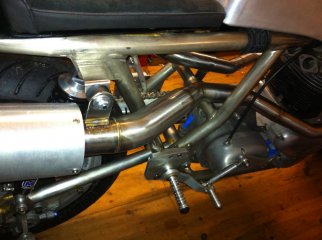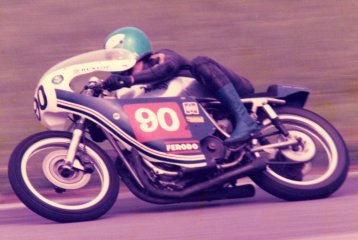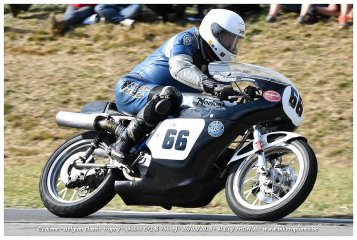You are using an out of date browser. It may not display this or other websites correctly.
You should upgrade or use an alternative browser.
You should upgrade or use an alternative browser.
Intresting 920 racer - 290 lbs
- Thread starter jseng1
- Start date
- Status
- Not open for further replies.
- Joined
- Oct 16, 2016
- Messages
- 411
One less thing to blow up! I am still trying to sort my oil tank out from the last outing.What are the advantages in getting rid of the oil tank?
Glen
SteveA
VIP MEMBER
- Joined
- Dec 20, 2011
- Messages
- 3,280
Back in the '70s when I started racing I met Bob Smith who ran a copy of the Dunstall spine frame. Bob and bike picture below. I never knew who had actually built his frame. Nor do I have any idea what happened to it after he moved on.
Bob hailed from St Helens so not that far from Aintree! He dragged over the Pennines week after week and won the Cadwell Park championship for most wins in a season on that bike, something like 50 race wins in the one season. I know it didn't have the fastest motor in it, mainly because on more than one occasion he offered me cash for my motor, which would readily pull away from his bike on the straights, but Bob was lightning fast. He ran a 750 and did all his own work, including rebuilding gearboxes most weeks! He later became British champion riding TZ750s and RG500s. Career sadly cut short at Scarborough in '83 after a fatal crash at the Mere hairpin.
There is a picture out there of Bob in exactly the pose of the picture of Steve's son. Except Bob is holding up one of Gary Bryan's BOTT Weslake/unit Triumph powered bikes, and it is totally complete with tanks seat, fairing and exhausts. You can find more on Facebook if you are interested https://www.facebook.com/groups/135274546982268

Bob hailed from St Helens so not that far from Aintree! He dragged over the Pennines week after week and won the Cadwell Park championship for most wins in a season on that bike, something like 50 race wins in the one season. I know it didn't have the fastest motor in it, mainly because on more than one occasion he offered me cash for my motor, which would readily pull away from his bike on the straights, but Bob was lightning fast. He ran a 750 and did all his own work, including rebuilding gearboxes most weeks! He later became British champion riding TZ750s and RG500s. Career sadly cut short at Scarborough in '83 after a fatal crash at the Mere hairpin.
There is a picture out there of Bob in exactly the pose of the picture of Steve's son. Except Bob is holding up one of Gary Bryan's BOTT Weslake/unit Triumph powered bikes, and it is totally complete with tanks seat, fairing and exhausts. You can find more on Facebook if you are interested https://www.facebook.com/groups/135274546982268
Last edited:
SteveA
VIP MEMBER
- Joined
- Dec 20, 2011
- Messages
- 3,280
You can put your exhaust system where others put an oil tank!What are the advantages in getting rid of the oil tank?
Glen
Attachments
SteveA
VIP MEMBER
- Joined
- Dec 20, 2011
- Messages
- 3,280
Nick Parovani in Norfolk, UK also built copies of the Dunstall drainpipe frame. There were know by the name of 'Quest' and were raced by Iceni Racing's rider Greg Page.
When I rode our member Chris's now totally yellow Rickman, which features in the bike build pages on here, it had a Parovani exhaust on it! I think it still does.
When I rode our member Chris's now totally yellow Rickman, which features in the bike build pages on here, it had a Parovani exhaust on it! I think it still does.
worntorn
VIP MEMBER
- Joined
- Dec 22, 2006
- Messages
- 7,955
Would there be any advantage to running a high exhaust vs the exhaust in the photo above?You can put your exhaust system where others put an oil tank!
I'm thinking the low centred exhaust above won't drag on corners and helps lower cog.
Also an oil tank vs oil in frame lowers cog a bit.
That might not be an issue with this drainpipe bike as the whole bike seems very low. Would be a cruncher for an older body I think!
The standard steel oil tank is just over 2 lbs. I was going to build one in Al but as the Al had to be thicker, weight advantage gone.
That big pipe looks heavy! Maybe it's thin wall and not that heavy.
Glen
SteveA
VIP MEMBER
- Joined
- Dec 20, 2011
- Messages
- 3,280
My Rickman has to have an oil catch tank as part of the fairing these days. Without the exhaust running under the frame the fairing can be held tight to the frame. If you notice the fairing lower has shaped clearance for the frame lower engine mounts.Would there be any advantage to running a high exhaust vs the exhaust in the photo above?
I'm thinking the low centred exhaust above won't drag on corners and helps lower cog.
Also an oil tank vs oil in frame lowers cog a bit.
That might not be an issue with this drainpipe bike as the whole bike seems very low. Would be a cruncher for an older body I think!
The standard steel oil tank is just over 2 lbs. I was going to build one in Al but as the Al had to be thicker, weight advantage gone.
That big pipe looks heavy! Maybe it's thin wall and not that heavy.
Glen
The rules of modern 'classic' racing drive you in a particular direction making high level exhausts more popular than they were. You cannot run a bike 'as it was' anywhere.
Actually in the Rickman since the oil also runs in the lower frame rails that will lower cog. Dunstall spine puts the oil forward of a tank and still keeps weight low. Key for Dunstall was as you say low height and weight, and I would say this applies to Seeley as well. Rickman was always heavier and taller, but generally more durable.
Back in the '70s my last exhaust on the same frame wasn't as neat as Gary's but it followed the same principle. Note how compressed the rear shock is in the photo, that is at the exit to Charlie's at Cadwell Park which can challenge the stability of many bikes.
39 years apart!, Same rider, same frame, pretty much everything else is changed.
Attachments
Last edited:
SteveA
VIP MEMBER
- Joined
- Dec 20, 2011
- Messages
- 3,280
Who actually made your frame?Nice, I went a little crazy and added some Ti, though mainly time spent with the bench drill, it can get a little addictive!!
- Joined
- Oct 16, 2016
- Messages
- 411
Mk4 1976 Seeley original, Mk3 R Titchmarsh copy. I like that photo, bike is hiding drainpipes and brothel creepers, was Bob a Ted (a UK reference)?Who actually made your frame?
SteveA
VIP MEMBER
- Joined
- Dec 20, 2011
- Messages
- 3,280
He wasn't really of the Ted generation and apart from the shoes and slim jeans I didn't see him dressed that way, but of course I mainly saw him in race paddocks.Mk4 1976 Seeley original, Mk3 R Titchmarsh copy. I like that photo, bike is hiding drainpipes and brothel creepers, was Bob a Ted (a UK reference)?
A lot who raced at Cadwell partied in Louth on Saturday nights, I am told Bob was up for a laugh then, but as a married serviceman who lived 15 miles away from Cadwell, I never did that.
He rode a Sunbeam S7 on the road! And he worked as a diesel fitter. His smile and humour were infectious, pretty much everyone who knew him liked him.
Check out the facebook link, it is run by his widow Lynda.
SteveA
VIP MEMBER
- Joined
- Dec 20, 2011
- Messages
- 3,280
Do you know if his frame is an original or a copy?Steve raced iot with CRMC in the late 80s
storm42
VIP MEMBER
- Joined
- Jul 20, 2011
- Messages
- 1,220
Good enough to be copied.


Andover Norton Motorcycle Sparts Specialist - Genuine Andover Norton Commando Factory Spare Parts - Genuine Andover Norton Dominator Factory Spare Parts - Andover Norton Motorbikes
Andover Norton Genuine Spare Parts: The exclusive Source of all Genuine Norton Commando and Norton Dominator Factory Spare Parts.
nvt-motorcycles.com
mdt-son
VIP MEMBER
- Joined
- Jan 19, 2012
- Messages
- 1,937
Re. pic 2 in #1, the lower tube run has a design deficiency. There should be a horizontal brace between the tubes as well as at least one brace each between the lower tube and the spine tube.
This is standard practice in steel design wherever a tube or beam changes direction. Forces have to be diverted at the joint, or out of axis bending will occure.
In trelli frames of the 90s this is demonstrated very well.
-Knut
This is standard practice in steel design wherever a tube or beam changes direction. Forces have to be diverted at the joint, or out of axis bending will occure.
In trelli frames of the 90s this is demonstrated very well.
-Knut
- Joined
- May 5, 2017
- Messages
- 657
Not the main advantage, I'm sure: the frame acts as a giant heat sink to cool the oil. Not an issue on a street Norton, but useful on a race bike. The large tube under the fuel tank gives a larger volume of space for the breather system.What are the advantages in getting rid of the oil tank?
Glen
t ingermanson
VIP MEMBER
- Joined
- Oct 17, 2018
- Messages
- 533
Happy to give it a go if you can get full size drawings.Here's another view. I think someone should be offering this frame. Eliminating the oil tank is very attractive.

t ingermanson
VIP MEMBER
- Joined
- Oct 17, 2018
- Messages
- 533
I agree that it's unusual that there's no bracing between the spine and the lower tubes (short of those tiny 3/8 tubes), or at least the spine and lower tubes crossing just short of the headstock. What forces do travel down the lower tubes would end up pushing (bending/flexing) the swingarm pivot out of axis. Might be a terrifying, or pleasantly soft ride.Re. pic 2 in #1, the lower tube run has a design deficiency. There should be a horizontal brace between the tubes as well as at least one brace each between the lower tube and the spine tube.
This is standard practice in steel design wherever a tube or beam changes direction. Forces have to be diverted at the joint, or out of axis bending will occure.
In trelli frames of the 90s this is demonstrated very well.
-Knut
Why I was previously asking about durability. Steel can wiggle and flex just fine (if that's the result you want) until it gets tired and breaks. But, if it was never designed to last more than a few years, then limited durability is fine.
Last edited:
Chris
VIP MEMBER
- Joined
- Jan 21, 2008
- Messages
- 1,630
They were being built in New Zealand . Also 6 we're made in Europe & posted on here 2010ish. Eligibility? This recent post states Paul saying 3 we're built. The man who made them says he made 6 & Kenny says 4. My friend still has his frame with road brackets. I would say that accounts for all of them. If Steve still has his.
Then again I may have Percys original
G P bike in the back of the shed!!!
Then again I may have Percys original
G P bike in the back of the shed!!!
- Joined
- Jan 6, 2009
- Messages
- 863
You can put your exhaust system where others put an oil tank!
Like this?
Do you know if his frame is an original or a copy?
I think it was original....not much demand for Drainpipe replicas when at the time you could have a Rickman/Seeley/Lowboy amongst others off the shelf
- Status
- Not open for further replies.



